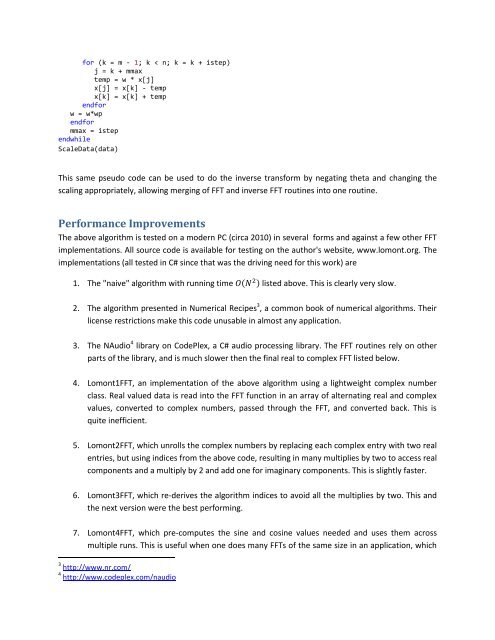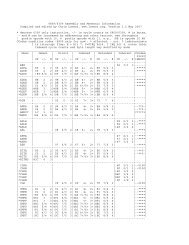Create successful ePaper yourself
Turn your PDF publications into a flip-book with our unique Google optimized e-Paper software.
for (k = m - 1; k < n; k = k + istep)<br />
j = k + mmax<br />
temp = w * x[j]<br />
x[j] = x[k] - temp<br />
x[k] = x[k] + temp<br />
endfor<br />
w = w*wp<br />
endfor<br />
mmax = istep<br />
endwhile<br />
ScaleData(data)<br />
This same pseudo code can be used to do the inverse transform by negating theta and changing the<br />
scaling appropriately, allowing merging of FFT and inverse FFT routines into one routine.<br />
Performance Improvements<br />
<strong>The</strong> above algorithm is tested on a modern PC (circa 2010) in several forms and against a few other FFT<br />
implementations. All source code is available for testing on the author's website, www.lomont.<strong>org</strong>. <strong>The</strong><br />
implementations (all tested in C# since that was the driving need for this work) are<br />
1. <strong>The</strong> "naive" algorithm with running time listed above. This is clearly very slow.<br />
2. <strong>The</strong> algorithm presented in Numerical Recipes 3 , a common book of numerical algorithms. <strong>The</strong>ir<br />
license restrictions make this code unusable in almost any application.<br />
3. <strong>The</strong> NAudio 4 library on CodePlex, a C# audio processing library. <strong>The</strong> FFT routines rely on other<br />
parts of the library, and is much slower then the final real to complex FFT listed below.<br />
4. Lomont1FFT, an implementation of the above algorithm using a lightweight complex number<br />
class. Real valued data is read into the FFT function in an array of alternating real and complex<br />
values, converted to complex numbers, passed through the FFT, and converted back. This is<br />
quite inefficient.<br />
5. Lomont2FFT, which unrolls the complex numbers by replacing each complex entry with two real<br />
entries, but using indices from the above code, resulting in many multiplies by two to access real<br />
components and a multiply by 2 and add one for imaginary components. This is slightly faster.<br />
6. Lomont3FFT, which re-derives the algorithm indices to avoid all the multiplies by two. This and<br />
the next version were the best performing.<br />
7. Lomont4FFT, which pre-computes the sine and cosine values needed and uses them across<br />
multiple runs. This is useful when one does many FFTs of the same size in an application, which<br />
3 http://www.nr.com/<br />
4 http://www.codeplex.com/naudio




